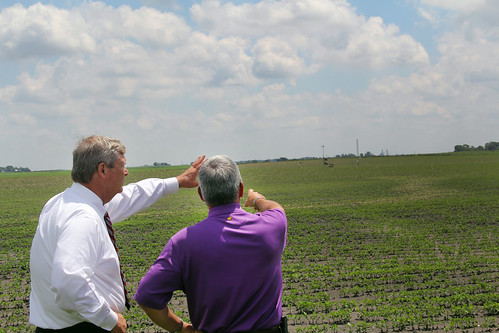
As world leaders gather in Paris this week to negotiate a new global climate agreement, it is important to recognize the contributions of farmers, ranchers and foresters in the United States towards achieving a more food secure world while adapting to climate change, increasing carbon sequestration, and reducing greenhouse gas emissions.
Over the course of my tenure as Secretary of the United States Department of Agriculture, U.S. producers have faced a record drought, which the University of California estimates has cost farmers in California alone an estimated $3 billion in 2015. We’ve seen increasing incursions of invasive pests and diseases and extreme weather, everything from bark beetle to severe droughts, which have cost billions in lost productivity. We’ve faced a series of record wildfire seasons in the western United States—the worst decade in U.S. history for wildfire. The growing El Nino weather pattern in the Pacific has created the perfect storm for disasters to strike the already damaged and weakened western landscape.
Tomorrow in Paris at COP 21, the U.S. Department of Agriculture will release a new report, titled Climate Change, Global Food Security, and the U.S. Food System. This report will outline the impacts of climate change on global food security, including food availability, access, utilization, and stability.
Never before has agriculture faced challenges of this magnitude. We’ve all seen the statistics: Nine billion people by 2050. Feeding these new citizens will require at least a 60 percent increase in agricultural productivity. We must do all of this in the face of climate change that is threatening the productivity and profitability of our farms, ranches and forests.
As we embark on our efforts, we have found that one of the first steps is to educate and inform our farmers, ranchers, and forest land managers – and our own USDA professional staff in the field – about climate change and the threats posed to our resources and the opportunities to contribute to solutions.
For example, earlier this year, USDA announced our 10 Building Blocks for Climate Smart Agriculture, a comprehensive set of voluntary programs and initiatives that we expect to reduce net emissions and enhance carbon sequestration by over 120 million metric tons of CO2 equivalent by 2025 - about 2 percent of economy-wide emissions, building upon a U.S. government-wide commitment to emission reduction. And through efforts by the federal government and a broad coalition of partners, the United States has restored more than 9 million hectares of lost or degraded forest since 2011 – more than half way to our Bonn Challenge commitment of restoring 15 million hectares by 2020.
We are promoting the building blocks strategy through our extension and technical service providers. To support our efforts, we have established a network of regional climate hubs to analyze risks and deliver localized information to help farmers adapt to climate change. We continue to support research into technologies and practices that will reduce climate risks. We are moving rapidly to integrate climate change into our domestic conservation and renewable energy programs.
Collectively, these efforts make U.S. agriculture and forestry a more publicly visible part of the climate change solution in the United States and abroad. They demonstrate to the world that these sectors can provide solutions to reduce greenhouse gas emissions, while simultaneously boosting productivity to meet growing demands for food and fiber, stimulating the rural economy, and offering compatible environmental and economic benefits.
We don’t face these challenges in a vacuum. These same conditions have dire effects across the world, especially for poor, rural smallholder farmers in developing nations. Drought in the western United States and drought in Central America threaten farmers and livelihoods, disrupt communities, and strain food systems. Increasing climate threats, whether it is drought, high temperatures, increases in pests, or wildfire, are separate symptoms of the same problem.
That is why the United States is committed to sharing information globally. The lessons we learn, we want to share through the Global Alliance for Climate-Smart Agriculture. Through our collective efforts, agriculture can make meaningful contributions to the effort to limit global temperature increases to less than two degrees Celsius. We are also proud of our efforts through the Global Open Data for Agriculture and Nutrition initiative, which supports efforts to make data available, accessible, and usable for unrestricted use worldwide.
USDA also directly supports international cooperation and development projects to help promote climate-smart agriculture. For example, last year we supported 11 Borlaug Fellows to work on climate change topics. This program allows agricultural scientists from around the world to work side-by-side with U.S. scientists on finding ways to increase food production while mitigating the effects of climate change.
In order to address climate change, we have to get ahead of it, and I’m convinced that no one innovates in the face of challenge better than agriculture. This will not be an easy task, but I am confident that working together and building on a legacy of partnership, efficiency and innovation, the Alliance members and other interested parties will continue to strive to achieve the three important goals of climate-smart agriculture: achieving food security, sustainably increasing agricultural productivity, and reducing greenhouse gas emissions, where possible.
Food security has implications far beyond what’s on our plates. A more food-secure, nourished world, able to feed itself and the future, is essential to the long-term prosperity and security of individuals, communities, economies, and nations.
